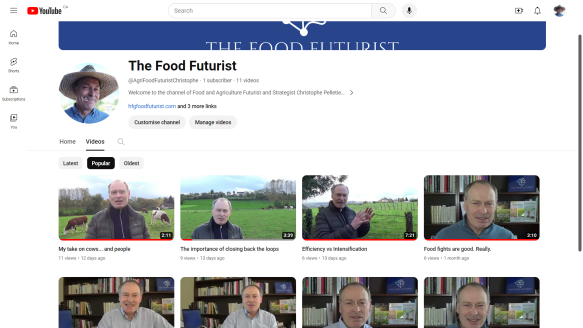It is just a month away from the 15th anniversary of The Food Futurist. In the course of these years, it has become increasingly clear to me that some areas need more attention and effective action for the food and agriculture sector to remain successful. Indeed, the future of food and agriculture is not just about what cute robots will do in the future and what funky foods scientists will figure out. It is much broader than that. It is about making the right things happen. In the end, it is not just about producing foods, but it is to produce them in ways that have a future, and also to sell them to increasingly critical and discerning consumers. This milestone anniversary seems like just the perfect opportunity for me to reflect and reshuffle my services to some extent. By doing this exercise, I have decided to introduce two new areas of services by May 1st 2024. These are areas where many organizations miss opportunities. These are also two areas in which I am quite qualified, for having delivered strong performance in my professional career.
The first one is centered on Regaining Trust
 It is no secret that trust is eroding in many areas. It happens with politics, with traditional media and even with some social media outlets, and it happens with food producers, especially the larger companies. One of the challenges that many food and agriculture organizations have been facing for decades is the loss of trust from consumers. The reasons why are many. Some are justified and some are not. Regardless of that, the loss of trust is a challenge that is becoming more and more difficult to overcome. In my career, I have had to deal with this problem in many occasions, but I always found ways of breaking the vicious circle of mistrust. In my opinion, the difficulty for organizations is not so much that people distrust some food producers, as it is to find the right way of addressing the issue and of truly creating a connection for a further conversation. PR does not work all that much anymore, simply because about everyone knows how it sounds and spot the communication exercise in action, which further erodes trust. Also, the timing is too often wrong and it makes the connection much more difficult. As a practitioner of martial arts for many years, I also see attempts to regain trust much more as an exercise in strength as one in flexibility and agility, and that is usually a losing tactic.
It is no secret that trust is eroding in many areas. It happens with politics, with traditional media and even with some social media outlets, and it happens with food producers, especially the larger companies. One of the challenges that many food and agriculture organizations have been facing for decades is the loss of trust from consumers. The reasons why are many. Some are justified and some are not. Regardless of that, the loss of trust is a challenge that is becoming more and more difficult to overcome. In my career, I have had to deal with this problem in many occasions, but I always found ways of breaking the vicious circle of mistrust. In my opinion, the difficulty for organizations is not so much that people distrust some food producers, as it is to find the right way of addressing the issue and of truly creating a connection for a further conversation. PR does not work all that much anymore, simply because about everyone knows how it sounds and spot the communication exercise in action, which further erodes trust. Also, the timing is too often wrong and it makes the connection much more difficult. As a practitioner of martial arts for many years, I also see attempts to regain trust much more as an exercise in strength as one in flexibility and agility, and that is usually a losing tactic.
As a teaser, here are the pillars that we will use to build the tailor-made programs. You need to Relate
R: Respect
E: Empathy
L: Listening
A: Authenticity
T: Truth/Transparency
E: Exchange
Trust is essential for an organization in order to have a solid future. In this respect, I believe that it fits very well with the activities of The Food Futurist.
The second area of service will be Second Opinion
 From what I have seen during my professional life, I believe that this is the kind of service that most organizations need. The number of strategic errors or implementation planning missteps that happen every day is there to prove that getting a second opinion is not a luxury, but in fact can prevent many costly mistakes.
From what I have seen during my professional life, I believe that this is the kind of service that most organizations need. The number of strategic errors or implementation planning missteps that happen every day is there to prove that getting a second opinion is not a luxury, but in fact can prevent many costly mistakes.
Sometimes, it is about getting things done in some rush to meet a deadline. Sometimes it is about an excess of optimism and self-confidence. Sometimes it is the lack of a new eye. You name it. There are many reasons why an organization overlooks some details, or is becoming somehow blind out of habit, or is too eager to jump an anything that looks like a trend out of fear of missing out. An independent and objective second opinion can save many headaches.
I see this service quite useful for established businesses, but also for young companies, and also for investors who might benefit from a second opinion before risking their money in the wrong concept.
This service, too, deals with the future and as such fits quite well with the activities of The Food Futurist. The format and scope of this service will be adaptable and tailor-made for the specific needs of the client.
Copyright 2024 – Christophe Pelletier – The Food Futurist – The Happy Future Group Consulting Ltd.


 If there is a never-ending feud in the food industry, the one here in British Columbia (BC) about farmed salmon certainly should be put on top of the list. The fight between salmon farmers and environmentalists has been going on for as long as the industry has been around, and it looks as if it will keep lasting for a long time to come.
If there is a never-ending feud in the food industry, the one here in British Columbia (BC) about farmed salmon certainly should be put on top of the list. The fight between salmon farmers and environmentalists has been going on for as long as the industry has been around, and it looks as if it will keep lasting for a long time to come. To attract new people to the food sector, it is also quite important to tell what kind of jobs this sector has to offer. These jobs need to be not only interesting, but they also must offer the candidates the prospect of competitive income, long-term opportunities, and a perceived positive social status. Many students have no idea about the amazing diversity of jobs that agriculture (including aquaculture) and food production have to offer. This is what both the sector and the schools must communicate. Just to name a few and in no particular order, here are some of the possibilities: farming, processing, logistics, planning, sales, marketing, trade, operations, procurement, quality, customer service, IT, banking and finance, nutrition (both animal and human), agronomy, animal husbandry, genetics, microbiology, biochemistry, soil science, ecology, climatology, equipment, machinery, fertilizers, irrigation, consumer products, retail, research, education, plant protection, communication and PR, legal, management, knowledge transfer, innovation, politics, services, etc… Now, you may breathe again!
To attract new people to the food sector, it is also quite important to tell what kind of jobs this sector has to offer. These jobs need to be not only interesting, but they also must offer the candidates the prospect of competitive income, long-term opportunities, and a perceived positive social status. Many students have no idea about the amazing diversity of jobs that agriculture (including aquaculture) and food production have to offer. This is what both the sector and the schools must communicate. Just to name a few and in no particular order, here are some of the possibilities: farming, processing, logistics, planning, sales, marketing, trade, operations, procurement, quality, customer service, IT, banking and finance, nutrition (both animal and human), agronomy, animal husbandry, genetics, microbiology, biochemistry, soil science, ecology, climatology, equipment, machinery, fertilizers, irrigation, consumer products, retail, research, education, plant protection, communication and PR, legal, management, knowledge transfer, innovation, politics, services, etc… Now, you may breathe again! fact, they will hardly listen. Therefore, words will have little impact, unless they go along with actions that confirm that the message is true. If the food industry does not want to change and hopes that communication will be enough to change the public’s mind, nothing will change. When you want someone to prove to you that he/she is reliable, you want to see tangible proof that something is changing in your favor. The most powerful communication tool that really works for regaining trust is the non-verbal communication. The distrusted one must sweat to win trust back. This does not take away that verbal communication must continue. It will keep the relationship alive, but it will not be the critical part for turning around the situation.
fact, they will hardly listen. Therefore, words will have little impact, unless they go along with actions that confirm that the message is true. If the food industry does not want to change and hopes that communication will be enough to change the public’s mind, nothing will change. When you want someone to prove to you that he/she is reliable, you want to see tangible proof that something is changing in your favor. The most powerful communication tool that really works for regaining trust is the non-verbal communication. The distrusted one must sweat to win trust back. This does not take away that verbal communication must continue. It will keep the relationship alive, but it will not be the critical part for turning around the situation. Opponents of agribusiness tell a lot about their opinions, they also show a lot of pictures, documents or footage of what they criticize, and they certainly are very active involving as many people as they can. The agriculture and food sector, including aquaculture, also tells a lot, shows some, but not enough about their daily operations, and they seem to have a hard time involving enough outsiders of the industry.
Opponents of agribusiness tell a lot about their opinions, they also show a lot of pictures, documents or footage of what they criticize, and they certainly are very active involving as many people as they can. The agriculture and food sector, including aquaculture, also tells a lot, shows some, but not enough about their daily operations, and they seem to have a hard time involving enough outsiders of the industry. As such, criticism is not a bad thing as long as it is not done in bad faith with the only purpose to bring damage. There is nothing wrong with consumers being concerned about the quality of the food they eat, and about the way it is produced. Being worried about whether and how antibiotics or hormones are used, about the potential problems to the environment linked to intensive production is quite legitimate when you are rather ignorant of production techniques. After all, nobody has ever claimed that any industry was perfect, and business is always work in progress. It is utmost important for all of us to have watchdogs in order to make sure that we do not get into excesses that can lead to irreparable damage.
As such, criticism is not a bad thing as long as it is not done in bad faith with the only purpose to bring damage. There is nothing wrong with consumers being concerned about the quality of the food they eat, and about the way it is produced. Being worried about whether and how antibiotics or hormones are used, about the potential problems to the environment linked to intensive production is quite legitimate when you are rather ignorant of production techniques. After all, nobody has ever claimed that any industry was perfect, and business is always work in progress. It is utmost important for all of us to have watchdogs in order to make sure that we do not get into excesses that can lead to irreparable damage. In my opinion, the only proper way forward about information on agriculture and food is transparency. Only transparency can eliminate (or at least reduce to a minimum) negative publicity. Only by being candid and open about the way food is produced, can the agricultural community inform properly the public.
In my opinion, the only proper way forward about information on agriculture and food is transparency. Only transparency can eliminate (or at least reduce to a minimum) negative publicity. Only by being candid and open about the way food is produced, can the agricultural community inform properly the public.